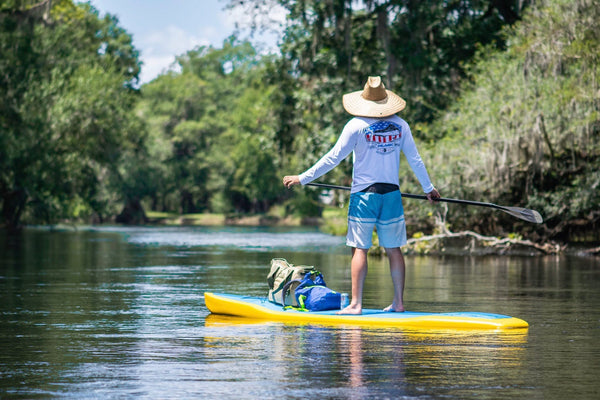
SUP Safety Tips
Embracing the serenity and adventure of stand-up paddleboarding (SUP) requires not just enthusiasm but also a commitment to safety. Whether you're a seasoned paddler or new to the sport, understanding and implementing key safety practices can significantly enhance your enjoyment on the water while safeguarding you and your companions. Below are indispensable safety tips every SUP enthusiast should follow.
Key Highlights
- Essential Safety Gear: Highlight the importance of a life jacket or PFD, whistle, and the right leash for different water conditions.
- Weather Awareness: Stress the importance of checking weather forecasts and understanding how wind direction affects paddling.
- Paddling Techniques for Safety: Detail alternative paddling techniques like prone paddling and kneeling to manage challenging conditions.
- The Buddy System: Encourage paddling with friends or informing someone about your paddling plans for added safety.
- Sun Protection: Tips on sunscreen application and wearing protective clothing to guard against sunburn.
- Appropriate Dressing: Advice on selecting the right clothing based on water temperature to prevent hypothermia or overheating.
- Board Maintenance: Guidelines on maintaining proper board inflation for stability and performance.
- Navigating Traffic: Recommendations for staying visible and safe in busy waterways.
- Safety Equipment for River Paddling: Emphasize wearing a helmet and using a quick-release leash in rivers.
- Self-Assessment: Advising paddlers to know their limits and paddle within their skill level for safety.
Besides the SUP safety gear that is mandated by the Coast Guard (outlined here) which includes a life jacket or PFD and a whistle, this post outlines some best practices for you to stay safe on your stand up paddle board.

1. Always Wear a Leash
Your SUP is your largest flotation device. Ensuring it's securely attached to you with a leash is crucial, especially in strong winds or currents that could separate you from your board. In whitewater make sure you use a quick release leash only!
2. Monitor the Weather
Stay ahead of the weather by checking forecasts before heading out. Paddling against the wind at the start means a smoother return journey, avoiding exhaustion and potential danger.
If you start your paddle with the wind, you can be pushed out farther than you had planned and you can find it extremely daunting to paddle your SUP back to your launch point.

3. Master Alternative Paddling Techniques
Prone Paddling: Lying on your board with the paddle under your chest allows for efficient paddling back to shore against strong winds.
Kneeling Paddle: In shallow or rocky conditions, paddling from your knees lowers your center of gravity, reducing the risk of falling and injury.
4. Adopt the Buddy System
Paddling with friends enhances safety. If solo, inform someone of your plans, including your route and expected return time.
5. Practice Board Recovery
Become proficient in flipping your SUP from upside down to right side up in deep water. Familiarity with this maneuver reduces panic and ensures quick recovery.

6. Sun Protection
Reflective rays from the water increase sunburn risk. Apply waterproof sunscreen with a minimum SPF of 30 and consider wearing sun-protective clothing.
7. Dress Appropriately
Choose clothing based on water temperature. In colder conditions, a wet or dry suit can prevent hypothermia, while summer paddles require lightweight, non-restrictive attire.
8. Maintain Proper Board Inflation
For inflatable SUPs, ensure your board is inflated to the recommended PSI (12-25) for optimal stability and safety.
9. Beware of Surrounding Traffic
In busy waterways, stay visible and alert to avoid collisions with boats or other paddlers, especially when ocean or river surfing.
10. Wear a Helmet and Quick Release Leash in Rivers
Essential for downriver SUP, a helmet protects against head injuries, while a quick-release leash can be a lifesaver in entanglement scenarios.

11. Know Your Limits
Overestimating your abilities can lead to dangerous situations. Assess your fitness, swimming skills, and balance to ensure a safe and enjoyable experience.
Conclusion: Safe SUPing for Endless Adventures
By adhering to these SUP safety tips, you'll not only ensure a safer experience on the water but also contribute to the overall enjoyment and longevity of your paddleboarding adventures. Remember, preparation and caution are the keys to unlocking endless adventures on your SUP.
For more SUP safety advice, gear recommendations, and paddling tips, stay tuned to our blog. Your safety is our priority, and we're here to support your paddleboarding journey every step of the way.
Following these SUP safety tips will not only make paddle boarding more enjoyable for you but they could potentially save your (or a friend’s) life. For SUP Fishing Safety check out this article!
Related Topics
5 Reasons Your SUP Should Be Your New Gym Pass


